Jaguarundi
Puma yagouaroundi
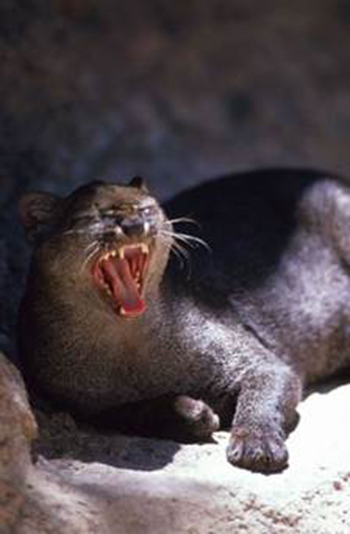
(Image source: nhptv.org)
Taxonomy:
Kingdom Animalia
Phylum Chordata
Class Mammalia
Order Carnivora
Family Felidae
General description
The jaguarundi is a relatively small cat, somewhat superficially resembling an enlarged housecat, but with a long, slender body and long tail. Due to this long, thin body and short legs, the body of the jaguarundi has been likened by many to the shape of a weasel or otter more than that of a cat. In fact, in areas of Mexico, jaguarundi are colloquially referred to as “otter cats” (nhptv.org). A typical adult male jaguarundi is around one meter from head to tail, with around half of the total length being the tail, and standing about 40 cm tall at the shoulder (NSRL at TTU). The jaguarundi’s head again appears similar to that of a housecat, but more extreme, with a flattened head, very short nose and snout and small, low-set rounded ears. Jaguarundi appear in two distinct color phases: the dark phase, which can appear anywhere from brown-grey to almost black, and the red phase, which is a lighter, more red-brown color. The two phases can be found within the same habitat and distribution, and readily interbreed (felineconservation.org).
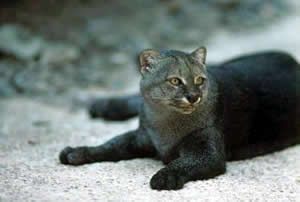
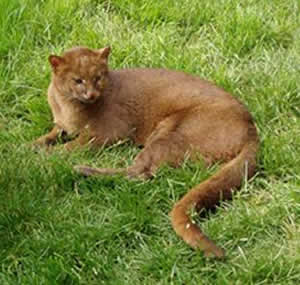
Dark phase jaguarundi (top), and light/red phase jaguarundi (bottom)
(Sources: nhptv.org,felineconservation.org)
Life History and Ecology
Range and Habitat
The jaguarundi occurs throughout the neotropics, from extreme southern Texas (where it is nearly extinct and extremely rare), along the eastern and western lowlands of Mexico, through most of Central America, throughout northern South America, Brazil and the Amazon basin, and south into Uruguay, Paraguay and northern Argentina. Jaguarundi inhabit a range of habitats, from near-desert thorn scrub to savanna and dry woodland to primary and secondary rainforest. However, in all of these habitats, the Jaguarundi prefers dense cover, making them somewhat uncommon in grasslands lacking dense scrub stands (IUCN.org). In all of these habitats, these cats are found almost without exception near running water (nhptv.org).
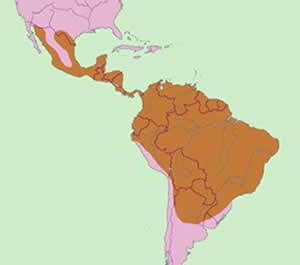 Jaguarundi Range Map
Jaguarundi Range Map
Source: theanimalfiles.com
Behavior
Jaguarundi are primarily terrestrial, but are noted for their good climbing and swimming abilities, both of which are employed in catching prey. While jaguarundi appear to be primarily diurnal, in some regions (such as in Texas), the species has been observed to be more crepuscular, or most active in the early morning and evening. Jaguarundi move and hunt in a manner similar to that of weasels, preying on small animals including birds, rodents and rabbits (Texas Parks& Wildlife). The jaguarundi has been noted as a very agile hunter, with one case of an individual observed leaping over 1.5 meters into the air and catching a dove in flight (NSRL at TTU). Further, jaguarundi sometimes exploit their swimming abilities to catch small fish, and some evidence exists of fruit being eaten on occasion (nhptv.org).
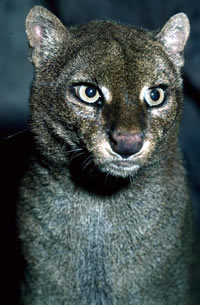
Reproduction
The jaguarundi is a solitary and non-social animal which can inhabit a home range of over 100 km2, one of the largest home ranges of any neotropical cat. Because of this, the species exhibits up to 13 separate vocalizations, used to communicate, mark territory and find mates (nhptv.org). Jaguarundi breed year round, with no defined mating season (NSRL at TTU). Typically, the female will give birth to between one and four kittens, which can be slate-blue or brown with spots that disappear as the kitten matures. After a month of weaning, the mother takes the kittens out of the den and teaches them to hunt for up to 10 months, when they will leave the mother (nhptv.org).
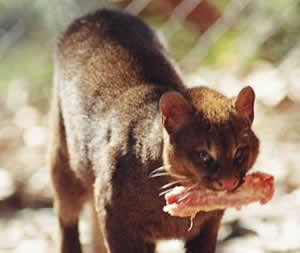
(Image source: felineconservation.org)
Ecological and Economic Significance
The jaguarundi is not particularly ecologically or economically significant, due to its thin numbers and reclusive nature (NSRL at TTU). Jaguarundi rarely interact or are even seen by humans, but may be hunted down regionally near settled areas for killing poultry. The greatest human threat to the jaguarundi, though, is not hunting, but habitat loss from deforestation and unsustainable agricultural practices (IUCN). Ecologically, the jaguarundi is not particularly important either: it fills an ecological niche overlapped by that of weasels and other smaller cat species (felineconservation.org). In fact, because of this, the jaguarundi is almost never the dominant cat species in an area and face stiff competition and population impact by larger cats, such as ocelots.
Recent Research
Due to the elusive nature and thin distribution of the jaguarundi, fairly little academic research exists on the species. Research tends to focus more on the ocelot, which is more prevalent than the jaguar, occupies a similar ecological niche, and often overlaps habitats and ranges that the rarer jaguarundi is found in.
One study, Movement Patterns and Food Habits of four Sympatric Carnivore Species in Belize, Central America, (Konecny, 1989), studied four carnivore species found in Belize, the tayra, ocelot, and margay, in addition to the jaguarundi, using radio telemetry tracking. Examples of each species were caught, measurements regarding size and diet were taken, and each fitted with a radio tracking device. Over the course of 21 months, the animals were tracked, establishing data on home ranges in hopes of understanding the correlation between interspecies interactions, diet, and home range size. The study showed that vertebrate prey provided 95-98% of ingested energy for the jaguarundi (as well as the ocelot and margay). The jaguarundi were found to exhibit the largest home ranges, with one example of up to 99 km2, and no significant habitat associations between the three cat species was found (Konecny, 1989).
A study by de Oliveira et al, Ocelot ecology and its effect on the small-felid guild in the lowland neotropics, sought to better understand the interspecific competition of various neotropical felids. The authors noticed that in numerous regions of the neotropics, two (or even several) species of felids with similar behavior, dietary, and habitat requirements coexisted in an area, and sought to observe whether the small-felid species (jaguarundi, ocelot, margay, etc.) in overlapping areas exhibited strong competitive intraguild interactions, especially in regards to the mesopredator theory. This theory predicts that as the top predator declines in an ecosystem, mesocarnivore numbers rise, while the decline of a potential competitor would broaden the niche of other competitors. The study found that, in the case of the jaguarundi and ocelot, the two species indeed exhibit intraguild competition, and the population density and numbers of jaguarundi in an area are negatively impacted by numbers of ocelots. Where the two share similar diets and habitats, the larger ocelot tends to push jaguarundi populations downwards (de Oliveira et al).
Personal Interest
I was always interested in big cats (jaguars, cheetah, etc.), and was quite surprised to find there was such a variety of wild cat species in the neotropics. While many of these, like the puma, margay and ocelot, looked familiar and not exactly out of the ordinary, I was intrigued by the weird, weasel-like shape (okay, and the name) of the jaguarundi. I found it quite interesting that, while these small cats inhabit a vast range and span all sorts of habitats (never knew they lived in Texas), they are extraordinarily reclusive and rare. I also thought that the competition between jaguarundi and other cats with the same ecological niche in parts of their range was fascinating, and part of the reason why these cats are so uncommon.
Links of Interest
Please note that the following links may have either been removed or relocated by the webpage owners since the time this student report was created.
http://www.nhptv.org/natureworks/jagurandi.htm Good broad information
http://www.youtube.com/watch?v=M_7LIodgOV8 Video of one of the many jaguarundi vocalizations
References
Please note that the following references may have either been removed or relocated by the webpage owners since the time this student report was created.
Felineconservation.org. Feline Conservation Federation. Web. 01 June 2012.< http://www.felineconservation.org/feline_species/jaguarundi.htm>.
Konecny, Michael John (1989) Movement Patterns and Food Habits of four Sympatric Carnivore Species in Belize, Central America. Advances in Neotropical Mammalogy. pp. 243-264.
Mammals of Texas Online Edition. Natural Science Research Laboratory at Texas Tech University. Web. 01 June 2012. <http://www.nsrl.ttu.edu/tmot1/feliyago.htm>.
NHPTV.org. Nature Works. Web. 01 June 2012.< http://www.nhptv.org/natureworks/jagurandi.htm>.
Oliveira, Tadeu G de et al. “Ocelot ecology and its effect on the small-felid guild in the lowland neotropics.” Ed. David W Macdonald & Andrew Loveridge. Methods Chapter 27 (2005) : 563–584.
Tpwd Animal Pages. Texas Parks and Wildlife. Web. 01 June 2012.< http://www.tpwd.state.tx.us/huntwild/wild/species/jag/>.